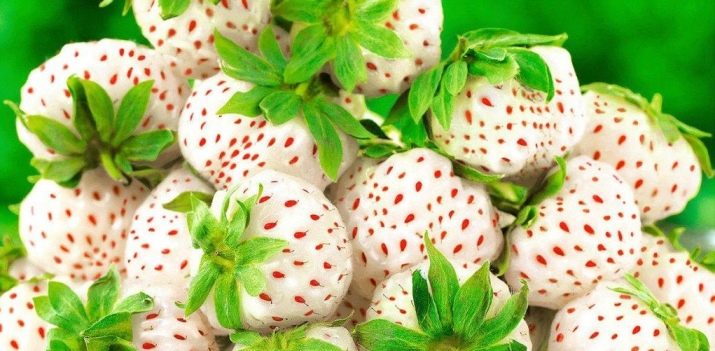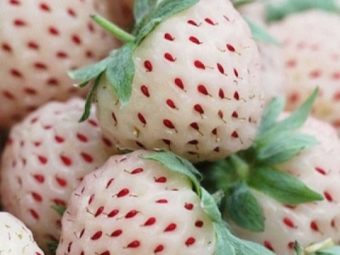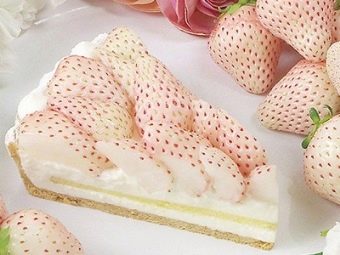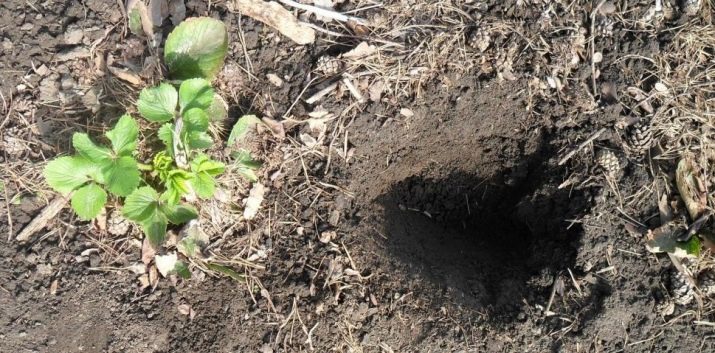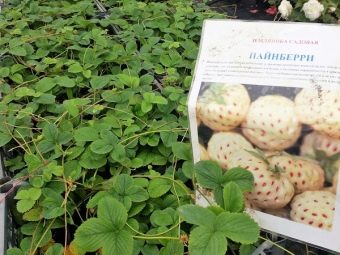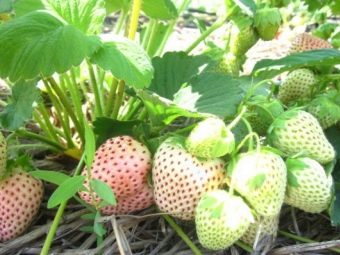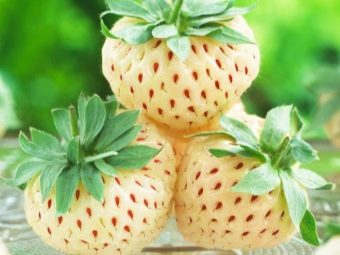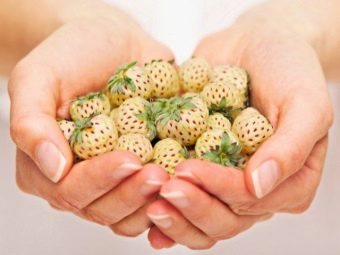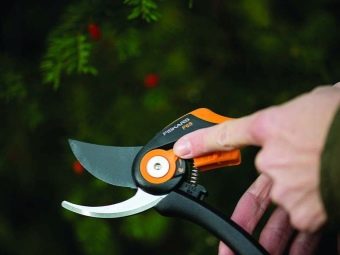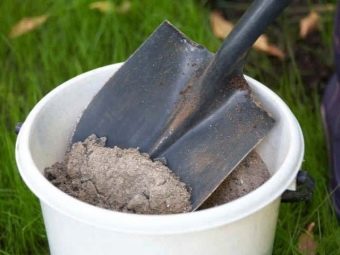Strawberry Pineberry: variety description, planting and care
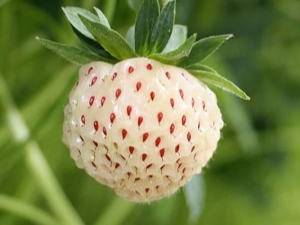
Even the most careful gardeners sooner or later try to master the cultivation of unusual plants.One of these options could be Strawberry Pineberry. It is only necessary to carefully study its features, and then a positive result will not take long.
Special features
"Pineberry" - developed in the past few years, remontant variety, obtained by hybridization of the Chilean and Virginian species. The authorship of strawberries belongs to Dutch breeders. The appearance of the garden culture is almost the same as that of the usual strawberry beds, the difference applies only to the color of the berries. But once you try them, it will become clear - these are fruits with the taste of pineapple. This property is embodied even in the title, which combines the English words "berry" and "pineapple".
By the way, such strawberries can be offered by sellers under other names:
- "White Pineapple";
- "Anastasia";
- "White Dream".
The berries are relatively small, their diameter is only 1.5-2.5 cm. When the crop ripens, instead of green, they often turn white, and red seeds create an unusual contrast. As soon as such a transformation takes place, the fruits can already be collected.
The tonality of the pulp has a wide variation, there are white, orange colors and intermediate shades. "Pineberry" - one of the dessert varieties, so these berries, as a rule, are eaten immediately after separation from the bush. Although some farmers have already appreciated the advantages of the original strawberry fruit in obtaining:
- ice cream;
- jam and jam;
- various drinks;
- baking.
Growing up
To find such a berry is quite difficult, even in European countries its production is small. The sizes of fruits are small, their popularity among consumers is limited. The agrotechnical approach is about the same as when working with classic varieties. The plant loves heat, which is quite typical for strawberries. Therefore, the culture gives the best results in the greenhouse. The earth is taken carefully to be dry and thoroughly warmed. White strawberries, which are planted on an open garden bed, can also grow well, then its fruits will get a pinkish hue.
The list of requirements for the quality of the soil is small, but they must be strictly followed. Optimal conditions are created in areas where the acidity is not less than 5 and not more than 6.5 units of the universal scale. First you need to feed the land. To do this, apply 5 kg of any organic matter and 0.04 kg of minerals per 1 m2. Please note that the strawberry "Pineberry" can not be grown from the purchased berries. The only breeding path is a mustache, and therefore farmers need to look for seedlings.
For planting strawberries need to use the wells, which depth is 70-100 mm. The reference point is the length of the root complex. Each notch is saturated with 0.5 kg of water, after which the division is inserted. The roots are supposed to be thoroughly straightened and slightly covered with earth. A common mistake of beginning farmers is excessively thick planting, since even small bushes feel better in the open.
Fruit maturity occurs in May, June and July. In greenhouses you can collect up to 1 kg per 1 square. m. The growth of the bush ranges from 0.2 to 0.3 m. In the winter, the strawberries will suffer cooling to -25 degrees. The plant does not attract the attention of birds, so the harvest is guaranteed to remain whole. Without a change of place, you can grow Pineberry for more than 5 years. The division is less practical than breeding a mustache. There are many branches of a bush, so there will be no shortage of them.
However, they sell seed for a high price because the variety is rare. It is recommended to loosen the soil between rows after removing the berries. Layers gently straighten, prikopav lower shares of sockets, but the apical bud should be above the ground.
When autumn comes, the roots will be quite developed. The mustache cut from the bushes is made by transplanting plants to the ridges. The depth of the holes at the time of landing should be up to 100 mm.When using purchased seedlings in a glass, planting is made with a clod of soil. It can not be destroyed.
Choosing seedlings is required very carefully. A good planting material should have bright green leaves. Evaluate their juiciness and see if there are any stains, mechanical defects. It is recommended to take seedlings with horns not less than 70 mm thick. Requirements for the selection are made even to the roots - the minimum length is the same 70 mm. Open roots should look like fluffy clumps. Saplings sold in cups must be pulled out and inspected. In the quality of planting material roots braid the entire amount of coma. If the plant will be planted not in greenhouses, but on open ground, one should give preference to sunny places located from the south.
Positive and negative sides
A natural question arises: if there is not much difference in agricultural technology, is it worth experimenting with “Pineberry” or is it better to prefer proven varieties. To understand this, every farmer will have to make an individual decision. So, white strawberry is quite resistant to a variety of diseases, which often fall on the planting of other varieties. Another advantage of the plant is self-pollination and the absence of the need for other auxiliary bushes. But if they exist, mutual cross-pollination and the loss of valuable qualities will be impossible.
But there are a number of weaknesses that should be known by all who decide to cultivate Pineberry. All the berries will be very tender and vulnerable, because they are not suitable for transportation. Even to pick and store the fruit will have to be careful. It is also necessary to take into account the relatively low yield of the variety. To collect a decent amount of fruit will turn out only over a large area. If prolonged rains begin, there is a high risk of damage to the landings with rot.
How to care
Caring for strawberries "Pineberry" is relatively simple. Trimming is carried out annually. It is possible in the autumn and spring months. But in any case, you want to get rid of worn leaves and whiskers. If the climate is very harsh, pruning should be done in the fall, then the bush should lose the lower tier of foliage and mustache. This technique allows you to eliminate the defeat of infections and to minimize the risk of pest invasion.
Primary feeding is carried out at the time of planting. At the exit of peduncles, recharge is made using organic matter and ash. For the third time, additional substances are added as soon as fresh budding starts. It is very important to mulch, which eliminates the aggression of weeds. After mulching the risk of rotting berries is significantly reduced. It is recommended to bind strawberry brushes to special stakes. This will further reduce the risk of pest eating.
Strawberry berries must be removed and packed with great care, but in capable hands this does not pose a problem.
Loosening the land between rows is 30-50 mm, otherwise the roots will be broken. After that it is recommended to water strawberries with warm water. Only not pure, but with the addition of copper sulfate or potassium permanganate. Both reagents are introduced in the amount of 1 g per 10 liters of liquid. As soon as the ovaries are formed, the treatment with boric acid (5 g per 10 l).
Optimal feed are the solution of cow or bird manure. Flowering is accompanied by a combination of the composition, where there is potassium and phosphorus. An alternative to this treatment is watering with diluted wood ash. The recommended proportion for dilution is 0.4 kg of ash per 10 liters of pure water. Watering activity is selected individually, taking into account the weather, most strawberries need liquid when laying buds, as well as when the berries ripen.
Watering is undesirable in the last 48 hours before harvesting. It is important to prevent the wateriness of the fruit. For mulching strawberries used peat, sawdust and chopped straw.Such substances, in addition to the conservation of moisture in the ground, allow the berries to become less dirty. Before the beginning of winter, it is worth feeding Pineberry strawberries, and with the onset of cold weather it is advisable to cover it with straw mats or fir-tree paws.
Views of summer residents
Despite some difficulties, the gardener's reviews of Pineberry strawberries are certainly positive. It grows well next to any other varieties. Even if the summer is dry, there is no danger for planting. Against the background of poor irrigation, the harvest will delight summer people.
Since there is no red pigment, the likelihood of an allergic reaction to such fruits is almost nil.
In the next video you can look at the Pineberry strawberry variety closer.

